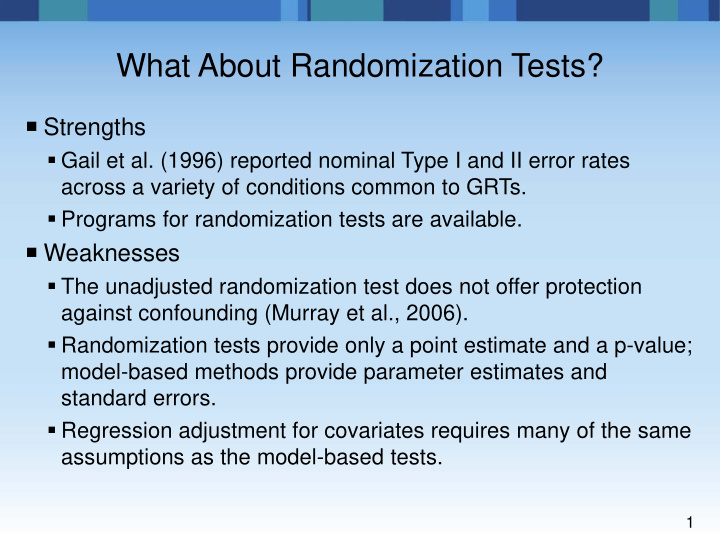



What About Randomization Tests? Strengths Gail et al. (1996) reported nominal Type I and II error rates across a variety of conditions common to GRTs. Programs for randomization tests are available. Weaknesses The unadjusted randomization test does not offer protection against confounding (Murray et al., 2006). Randomization tests provide only a point estimate and a p-value; model-based methods provide parameter estimates and standard errors. Regression adjustment for covariates requires many of the same assumptions as the model-based tests. 1
What About Generalized Estimating Equations (GEE)? Methods based GEE use an empirical sandwich estimator for standard errors. That estimator is asymptotically robust against misspecification of the random-effects covariance matrix. When the degrees of freedom are limited (<40), the empirical sandwich estimator has a downward bias. Recent work provides corrections for that problem; several have been incorporated into SAS PROC GLIMMIX. Methods that employ the corrected empirical sandwich estimator may have broad application in GRTs. 2
What About Fixed-Effect Methods in Two Stages? Introduced as the first solution to the unit of analysis problem in the 1950s. Commonly known as the means analysis. Simple to do and easy to explain. Gives results identical to the mixed-model ANOVA/ANCOVA if both are properly implemented. Can be adapted to perform random coefficients or growth curve analyses. Can be adapted to complex designs where one-stage analyses are not possible. Used in several large trials, including CATCH, MHHP, REACT, CYDS, and TAAG. 3
What About Deleting the Unit of Assignment From the Model If It Is Not Significant? The df for such tests are usually limited; as such, their power is usually limited. Standard errors for variance components are not well estimated when the variance components are near zero. Even a small ICC, if ignored, can inflate the Type I error rate if the number of members per group is moderate to large. The prudent course is to retain all random effects associated with the study design and sampling plan. 4
What About Unbalanced Designs? Imbalance at the group-level can create analytic problems (Gail et al., 1996; Murray et al., 2006). Balance at the group-level is usually easy to retain. Imbalance at the member level can create Type I error inflation and the risk increases with the level of imbalance. Member imbalance is almost universal in GRTs. Johnson et al. (2015) compared 10 model-based approaches to member imbalance in GRTs. A one-stage mixed model with Kenward-Roger df and unconstrained variance components performed well for g>14. A two-stage model, weighted by the inverse of the estimated theoretical variance of the group means, and with unconstrained variance components, performed well for g>6. 5
What About IRGTs In Which Members Belong to More than one Group or Change Groups? The literature on IRGTs has focused on the simplest situation in which each member belongs to a single group and group membership does not change. That pattern is not likely to hold in practice. Andridge (2014) has shown that failure to account for multiple group membership can result in Type I error inflation for the methods described thus far. Roberts (2013) has shown that multiple membership multi- level models address this problem. They require data on membership time in each group, which is not routinely collected in IRGTs. 6
Recommend
More recommend